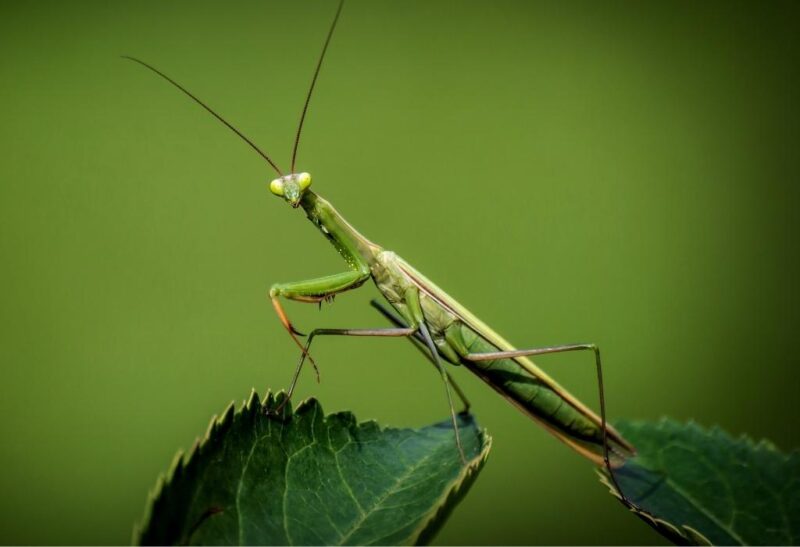There are two species of praying mantis that are common in North America. They’re Chinese mantis (Tenodera aridifolia) and European mantis (Mantis religiosa).
They’re both seen in brown, green, and morph hues. Aside from being ferocious predators, mantises have interesting colors.
Why are praying mantis different colors? Apart from being brown and green, mantises can be black, white, pink, and yellow. The habitat’s light intensity, temperature, and humidity cause the different colors. Some of them can change from brown to green and vice versa during the molting period. Some praying mantises turn brown when still a nymph. However, these color changes only last for several days.
Still, the colors brown and green are useful for camouflage since they’re the colors of nature. It’s easy for a praying mantis to perch on brown or green leaves and wait for its prey since it’s a sit and wait for the predator, as mentioned in a study.
But you should know that praying mantises don’t dramatically change color like chameleons. Thus, the color change that takes place in the molting stage is not relevant to a quick camouflage.
Nonetheless, it’s amazing that they can take advantage of the color and light of the surrounding for various coloring.
Table of Contents
Praying Mantis | Colors, Origin, and Habitat
Green Praying Mantis
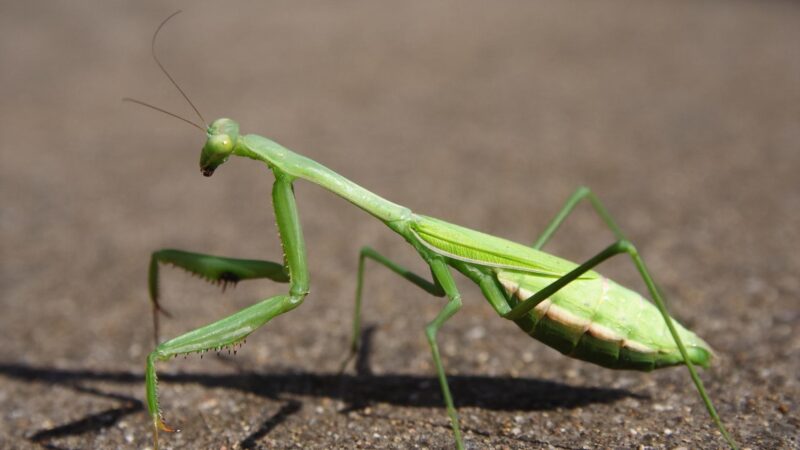
Adult Mantis religiosa is typically the green praying mantis. This species is found in the United States, but it’s originally from Europe. It’s widespread since it can adapt to different areas.
As a matter of fact, it can be seen in every part of the world. They grow wings when they’re adults so they can efficiently attract a mate and catch prey. Other species of green mantis would appear like leaves. The green ones that live among grasses are slender.
Black Praying Mantis
Most people are not aware of the existence of black praying mantis or bark mantis. It’s a rare one that is from Southeast Asia. Moreover, it appears iridescent most of the time, but there are variations in coloring.
This species is unique among other mantises as it has a shorter thorax. The ideal habitat for black praying mantis is under the bark of a tree where termites may be hiding.
In this area, it has easy access to its food source. Instead of practicing ambush attack, which is a common practice among praying mantis, it chases its prey.
Another exemption to this species is cannibalism which is practiced by other female mantis species during mating. Black mantises only grow up to one inch and a half when they reach maturity.
As you can imagine, it has a different appearance from the common mantis. Because of it, you might mistakenly think of it as a beetle or cricket.
There’s no finding yet about the exact reason for the black coloring. But the research that was conducted in the Philippines where some bark mantises live led to the discovery of some brown mantises with random black spots. This coloring is akin to the bark of the tree where they take residence.
White Praying Mantis
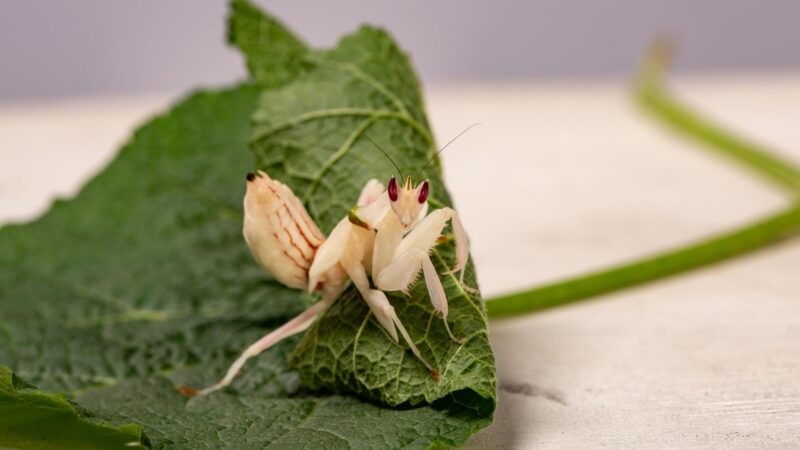
Excluding its wide abdomen, this white praying mantis looks like the traditional green species. It can only be found in some places but mostly in the west. The color of its body is the perfect camouflage in deserts.
Though other mantis species are white when they’re young, this one maintains the color until adulthood. Note that a praying mantis can molt around 10 times on its way to maturity.
As they grow older, the color darkens until they reach their real body hue. So, some may think that it’s an albino, but it’s a white mantis to be exact. If it’s not, it’s the young of other species.
Brown Praying Mantis
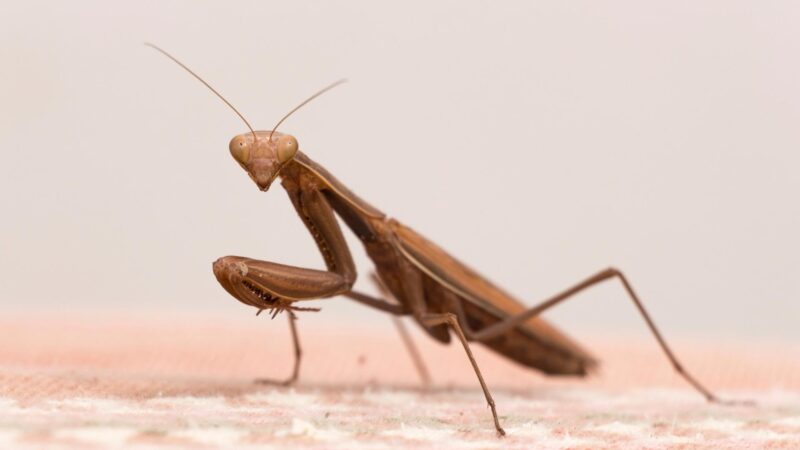
The brown praying mantis takes the second spot after the green one in the list of the most common mantis species. This is a member of the genus Mantodea that is related to termites and cockroaches. Based on its coloring, it mainly lives in branches and trunks of trees.
It also likes to hide in dry places like within a shrub or bush. This species prefers places with warmer climates and not intense winters. It mainly lives in Africa, but it can also be found in Southern Europe.
For some obvious reasons, the brown color helps them unite with their surroundings. Furthermore, it’s common to see a mantis that looks like a twig.
Don’t be surprised as well if you see brown mantis without wings, but some have them. Having a pair of wings is advantageous for praying mantis. It’s a means of transportation and a way to catch a moth.
The smallest brown praying mantis called the ghost mantis has a maximum length of two inches. It appears like a decaying leaf as there’s a leaf-like protrusion on its limbs, and it has a flattened thorax.
Pink Praying Mantis
This is also called orchid mantis, as its appearance suggests. It’s another native mantis species of Southeast Asia. It has undeniably attractive coloring that makes it mingle well with an orchid.
Despite its four legs that are like flower petals, it has forelegs that can grasp any prey that it can find. Apart from its great disguise in hunting, it’s also applicable when hiding from predators.
The female pink mantis is in the regular size, but the male is only half of it. You’ll see them in various pretty shades of pink. Some pink mantises can also have brown coloring in some instances. It’s not only the attractive color that makes this mantis a sought-after species but the challenge in finding it in nature.
Yellow Praying Mantis

The yellow or golden praying mantis is a large species that lives across Southeast Asia. It can grow up to 3.5 inches, and females are larger than males. Due to their size, some yellow mantises are in zoos and aquariums.
Hobbyists like them as pets. They reside in thick shrubs and trees. From beige to yellow, their color can change into brown and green in just a matter of days.
What Color are Male and Female Praying Mantis?

A female mantis is larger than the male, but the latter has bigger eyes and antennae. Julio Rivera, Ph.D., is an entomologist who saw the green female mantis in a museum in Paris. He also saw a small male brown mantis at the California Academy of Sciences.
As Rivera worked with other field experts, they found out that both of the mantises that he saw are from the Antemninae family based on their features.
In connection with this, Neil Reid, who is a lecturer from Queen’s University located in Belfast, made further research. He observed some mantises as they develop into adulthood. His findings include that the female mantises look similar to what is in the museum in Paris, and the male ones are copies of what Rivera saw in California.
But what the entomologist saw is not enough evidence that male and female mantises have different colors. The mantis coloring is connected with convergent evolution in which animals copy the color of their surroundings. Therefore, unrelated species regardless of gender can have the same color.
Anyway, determining the gender of a praying mantis is not about color but through sexual dimorphism, just like most animals. For instance, male mantises have 7 segments while the females have 5.
Gender identification among mantises can be done with ease when taking their sizes as a basis. You can do the selection right away since adult females are larger than their male counterparts.
Do Praying Mantis Change Color?
Young mantis starts with white color, which darkens over time as it gets older. When it reaches adulthood, it remains with its original color. Typically, the color that it bears represents its habitat. Some mantises display various colors, but a single hue would stay for a few days before the shift.
What Does it Mean When a Praying Mantis Changes Colors?
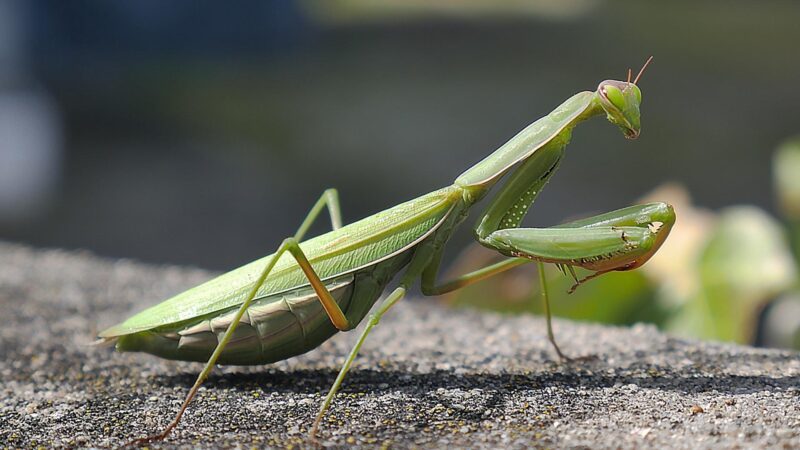
When a praying mantis changes colors, it means that there are changes in the temperature and humidity in the area where it lives. The light intensity in the surrounding has a contribution to these changes as well.
Why Are Praying Mantis Different Colors?
The different colors of the praying mantis are based on its environment. For example, the brown mantis gets its color from the bark that it lives in.
Does Praying Mantis Get Their Color Right After Hatching?
Although the praying mantis looks like its adult version but is just smaller after hatching, it undergoes the process of molting, which is shedding its exoskeletons. This process doesn’t only allow growth for a bigger size but to achieve a distinct color. Thus, a prayer mantis doesn’t get its color right after hatching.
Summary
Praying mantis can have different colors because of adapting to their environment. Light intensity, temperature, and humidity have contributions too. But these things fall into the mantises’ goal to camouflage.
It makes them effective in catching prey and hiding from predators. In human eyes, praying mantises in various colors make them fascinating creatures.
List of Sources
Carle, T., Horiwaki, R., Hurlbert, A., Yamawaki, Y. (2018). Aversive Learning in the Praying Mantis (Tenodera aridifolia), a Sit and Wait Predator. Journal of insect behavior.
Schwarz, S. J. (2021). Three new praying mantises from Panay Island, Philippines (Insecta: Mantodea). Integrative Systematics: Stuttgart Contributions to Natural History.
Garvey, K. K. (2018). How to Find a Praying Mantis. Agriculture and Natural Resources, University of California.
